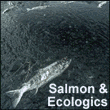forum
library
tutorial
contact

Scientist Links Equator Climate to NW Salmon Health
by Mike O'BryantColumbia Basin Bulletin - February 28, 2003
|
the film forum library tutorial contact |

|
Scientist Links Equator Climate to NW Salmon Healthby Mike O'BryantColumbia Basin Bulletin - February 28, 2003 |
A narrow band of productive cold water off the Oregon and Washington coasts and up to Alaska that contributes to the health of salmon runs in the Northwest is impacted by climate changes occurring as far away as the equator, according to atmospheric scientist Dr. Nathan Mantua of the University of Washington's Department of Atmospheric Science.
Pacific salmon are found almost exclusively in this narrow band of cold water that can be as wide as 80 miles off the Oregon and Washington coast lines, but the size and location of this band of productive water with high concentrations of phytoplankton is dynamic and one reason is climate. The distributions of salmon follow the cold water and salmon migrations also follow the seasonal changes in ocean temperature.
Mantua, speaking at a seminar hosted by the Native Fish Society in Portland last week, said Oregon coho stay within 20 miles to 80 miles off the coast, largely remaining within the cold water zone. He pointed to an Oregon coastal coho spawner count in 1996 of about 30,000 fish, which rebounded to 300,000 spawners in 2002.
"I argue that climate is a part of that story," Mantua said, pointing to four factors that affect climate in Northwest coastal areas. They are upwelling winds, coastal upper ocean temperature, El Nino and El Nina, which originate in the equatorial Pacific Ocean, and the Pacific Decadal Oscillation (PDO).
"In the early part of this century, habitat quality and quantity and species diversity were relatively high," Mantua said. "Poor ocean conditions, among all the reasons for salmon decline, is the only one we haven't had anything to do with."
During the cold months -- October through March -- an Aleutian low pressure center results in the counterclockwise flow of winds off the coast. The winds drag at the water, which deflect off the coastline, leaving a vacuum along the coast, pulling towards the surface cold water from deeper water. This upwelling pulls nutrients up into surface waters along the shoreline. The further off the shoreline the less nutrients. There is little stratification of temperatures during this period.
That changes in the summer and during El Nino years as warmer air and ocean surface temperatures move north. The shoreline ocean becomes more stratified, cutting off food web production and bringing in subtropical species, such as predators that would normally be found in waters to the south.
El Nino, which is often blamed for Northwest salmon problems, Mantua said, typically results in a strongly stratified coastal ocean with a warm coastal current, and with a warm winter and spring and low stream flows. It's not a local phenomenon, but originates from the tropical Pacific Ocean where ocean temperatures as high as 80 degrees Fahrenheit can spread from the far western Pacific nearly to South America. That warm pool fuels a lot of rain.
Mantua pointed to El Nino events which had large impacts on climate in the Northwest, including a strong El Nino from December 1997 to February 1998 that caused rains in South American deserts. That was followed -- December 1999 to February 2000 -- by a La Nina.
La Nina's typical impact on Northwest weather is more storms, snowpack and higher stream flows, along with cooler and weakly stratified water along the coast.
These changes happen frequently, he said, and are completely natural phenomenon. In addition, they move quickly due to the strong currents and temperature contrasts that create winds that move the warm water around.
The Pacific Decadal Oscillation is a longer-lived climate pattern of about 20 to 30 years, Mantua said. For the Northwest, warm extremes occurred during the periods 1925 to 1946 and 1977 to 1998. The colder cycle was 1947 to 1976 and from 1998 through today.
"We don't know how to predict the PDO or even where it is headed in the next few years," Mantua said. "It is more observational and less predictable."
For today's climate, the most recent El Nino peaked in early February and will be gone by March, he said. If a windy summer doesn't turn the currently warm ocean temperatures around (they are about 2 degrees Fahrenheit warmer than normal), he said juveniles leaving the river to go into the ocean this spring and summer would be going into a warm ocean. The good news, on the other hand, is that returning chinook and coho salmon are returning from overall good ocean conditions.
Although Mantua has linked climate with Northwest ocean conditions and so to the health of salmon, he concluded that "predicting salmon productivity in the ocean is not going to be possible. We cannot account for all the factors."
Related Sites:
Dr. Nathan Mantua: www.atmos.washington.edu/~mantua
Native Fish Society: http://home.teleport.com/~salmo/
learn more on topics covered in the film
see the video
read the script
learn the songs
discussion forum
